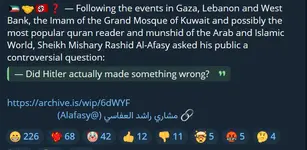“We are unable to favor this movement. We cannot prevent the Jews from going to Jerusalem – but could never sanction it. The ground of Jerusalem, if it were not always sacred, has been sanctified by the life of Jesus Christ. As head of the Church, I cannot answer you otherwise. The Jews have not recognized our Lord, therefore we cannot recognize the Jewish people. And so if you come to Palestine and settle your people there, we will be ready with churches and priests to baptize all of you."
You are using an out of date browser. It may not display this or other websites correctly.
You should upgrade or use an alternative browser.
You should upgrade or use an alternative browser.
The Israel-Hamas War Lounge
- Thread starter Ember
- Start date
Different people.Is it me or is Devon Stack also Andrew Anglin?
Who needs "blood libel" when they're literally rolling up their sleeves for it?
Danke schön: German Air Force commander arrives in Israel to donate blood

Danke schön: German Air Force commander arrives in Israel to donate blood

Attachments
More close quarters fighting footage. Just looking at this video and others comparing it to footage I seen from battles like Fallujah, Mosul, Siege of Marawi, soldiers were on foot mostly. Armor and vehicles were held back unless they were being brought up to provide support. This footage is reminding me of the Battle of Grozny in the first Chechen War, units unorganized and being just thrown in haphazardly.
This footage reminds me of this. Who knew Hamas watched Garand Thumb.
There's nothing new in underground strongholds: tunnels of Iwo Jima, Cu Chi tunnel network in Vietnam, Tora Bora caves in Afghanistan - to name just a few from recent history. And, of course, mines and industrial "tombs" of present day war in ukraine. The thing that makes Hamas tunnels unique, is their location under a dense urban area, which takes, the already difficult, urban warfare to another level.
Yes, there were (or still are) tunnels going into Egypt, that were used for years to smuggle weapons, munitions, etc. into the Strip. The Israelis claim they destroyed those tunnels in the first few days, but whether they were able to completely destroy them, just shut them down temporarily, or even locate all of them is open question.
They used to have many of those, to send out infiltration teams, launch raids against Israeli border forces, and kidnap soldiers (the famous Gilad Shalit case) in the past. But the Israelis recognized the threat and begun to search and destroy them and, eventually, they installed an underground border wall to prevent any further incursions - at least in theory, but in practice there's nothing they can do to prevent them - Hamas can always dig another tunnel under the concrete barrier, and as long as they don't use any power tools they can avoid triggering the sensors. It's a dangerous job, and the capacity of those "hand made" tunnels is low, but some of them could still be there - according to some sources, assault tunnels have been used on October 7. However the remaining cross border tunnels are of little value at this stage, there's not much that a small team could do to the Israeli forces in the deep rear - any acts of sabotage against fuel and ammo dumps can be achieved using drones - and the entire Gaza envelope is a closed military zone so there's little to no chance for deep terror raids. On the other hand, tunnels inside the Gaza Strip that lead behind the Israeli strike forces, are of great value - they allow Hamas to strike at the IDF's rear units (that Merkava that was taken out at point blank range was left without any infantry cover in a "safe" zone on fire support duty).
They won't last that long. As impressive as those tunnels are, they are facing two major problems.
First is their quality. Those tunnels were built without the use of specialised engineering equipment, since the Israeli blockade prevented their transfer, Hamas could only use jackhammers, drills, shovels. Same goes for the quality of building materials - You think that they were allowed to import high grade concrete into Gaza ? And what's the condition of those tunnels after a month of heavy bombardment? How many tunnels collapsed, how many underground chambers were hit directly with bunker busters, how many shafts were burried under the rubble ?
The second is sustainability. How much food, water and fuel they have in storage ? What about munitions ? Diesel generators and spare parts for them, and what about exhaust fumes? With all those buildings above, razed to the ground by the Israelis, even access to breathable air is in question.
We burned the Japanese on Iwo Jima with napalm, used a combination of carpet bombings and an infantry combing operations against the Vietnamese but it failed. Soviets took Tora Bora by assault, we did it with heavy bombardment.
What will the Israelis do ?
For starters they need to locate and "cut" the main underground lines that connect the, besieged, northern part of the Strip with the south - because at this moment Hamas still has freedom to move resources and fighters from one end of the Strip to the other. When, or if, it's done, they will go to work on the northern undergound. How ?
- With the main supply tunnels sealed, they could simply besiege those Hamas fighters that are trapped in the north - but it's unlikely, time is not on the Israeli side, they lose western support with every atrocity they commit.
- Raze the entire city of Gaza to the ground, collapse as many tunnels as possible and burry Hamas alive under the rubble.
- Chemical warfare. Could be lethal nerve agents, could be non-lethal smoke.
- Flush the tunnels with water. Back in 73, during the Yom Kippur war, Egyptians used industrial grade water pumps to breach Israeli lines along the Suez Canal, so it's not as crazy as it sounds.
- Combing operation. Once the ground forces secure an area above ground, they will locate the main communication tunnels and collapse them to cut off the block from the rest of the network. Afterwards they will move below (preceded by grenades) to clear the isolated section. Then move on to another city block: secure the surface, isolate local tunnels from the network, clear them. Rinse and repeat, one city block after another.
- Any combination of the above.
Again, it all depends on how well prepared these tunnels are. If these tunnels go miles deep, no bunker buster bombs will matter. If they are properly ventilated and equipped with drainage systems, no amount of water or nerve gas will do anything. They could have a power cable running to Egypt miles underground that no one knows about. They could have massive hydroponic farms, massive caverns filled with oil, oil and gas generators, etc. Sky's the limit, the question is how big and how developed are these tunnels? 20+ years with 500K men comitted to ideological fervor is huge cheap labor pool. Iran could easily fund the construction of a massive underground labyrinth for 10-20 million if the Hamas fighters are working for God.
That said, there might be little underground, or it could be a giant surprise. If Hamas was planning this all along and it turns out to be a giant military base that goes for thousands of miles underground, than Israel has walked into a deathtrap.
Central Turkey, Cappadocia region has a history of hiding in cave/tunnel cities. Some are now museums.Right now I'm wondering just how extensive the tunnel network under Gaza really is. If Hamas has been preparing for this war for 20+ years with a massive tunnel network capable of holding millions underneath thousands of miles of a subterranean fortress, then this Gaza siege will last for years and perhaps longer than a decade.
There could be tens of thousands of entrances, many of them obscured by rubble from the bombing campaigns, which makes it impossible to find them without getting killed by guerilla fighters. Combined with Hamas drones, explosives, the IDF will be getting picked off every single day. It sounds like it will be impossible to avoid casualties, and if the IDF is merely trading 1 soldier for even 5 Hamas, then Israel loses because they do not have near enough numbers to sustain those kinds of losses like Muslims do.
Never in the history of warfare have I learned about a vast underground city fortress. The closest analogy would be fantasy dwarves, haha. Of course, it could all be overblown and the tunnel network may be marginal. But, why would Hamas attack? It seems to me they wanted to bait Israel into attacking, which means they've been preparing for this.
The Hamas under-fortress may be one of the largest undertakings of it's kind in the history of humanity, some kind of crazy adaptation to being bombed by Israel for over 50+ years. How much have Hamas prepared for this? Do they have tunnels into Egypt for more supplies to be smuggled into the city? Do they have tunnels outside of Gaza into Israel to launch flanking attacks or terrorist attacks? Do they have a massive drainage system into the Mediterranean to prevent flooding?
If there is a truly massive underground city then the IDF will be playing Islamic whack-a-mole for years and years. It will be extremely costly and the death toll of the IDF could easily reach 100k+ on a long enough timeline.
This is quite unlike anything I've learned about before so if anyone has more knowledge on these tunnels I'd be happy to learn more. But it seems like Hamas has been hiding their real plans up until this point, so I'm not sure how anyone could know.
Even the Wikipedia article has scant details, but they have found one tunnel before in 2014 that was 62 miles long!!
How would modern armies even fight this kind of a fortress? I'm not sure modern armies are equipped to crack something like this open. No wonder the Israelis are ready to use nukes.
It's different, they were digging through very soft rock, which also has the property of structural integrity; once you dig, you don't need to reinforce it.
Between the Roman, Byzantine, and other periods, people would take their villages inside of the cave network and hide for extended periods.
The caves were cramped of course, but still had kitchens with cooking vents that were dug diagonally so that intruding armies couldn't just see smoke coming up and dig straight down and find them.
They even had stables to keep livestock alive! Food is one thing, but storing large amounts of water sounds incredibly difficult at that time. Supposedly they'd mix it with wine to kill some of the bacteria.
Amazing what people used to do.
10-20 million? That sounds a little fantastic.Iran could easily fund the construction of a massive underground labyrinth for 10-20 million if the Hamas fighters are working for God.
That said, there might be little underground, or it could be a giant surprise.
10-20 million? That sounds a little fantastic.
Not at all, you've got men who are willing to work for the basics: food, shelter, and a wife. Wages not necessary beyond this. Then you've got dollars being converted into Egyptian Pound, which is worth far less than US Dollars:
So as long as the $20 million is used to build cheap housing above, plus food (which to be fair the local economy of Gaza can probably support itself enough to provide food, plus international aid), then all the rest can go to digging equipment, electrical equipment, some metal for tunnel supports, which Iran all gets for cheap from China and Russia.
I have no idea how zealous the Palestinians are, but if they are willing to work for essentially free then a massive underground complex is indeed possible on the cheap.
Looks like ISIS has been unleashed - and obviously on the US/Israel side.
Total miscommunication. Getting a bunch of tunnels built for $10-20 million USD is totally reasonable.Not at all, you've got men who are willing to work for the basics: food, shelter, and a wife. Wages not necessary beyond this. Then you've got dollars being converted into Egyptian Pound, which is worth far less than US Dollars:
So as long as the $20 million is used to build cheap housing above, plus food (which to be fair the local economy of Gaza can probably support itself enough to provide food, plus international aid), then all the rest can go to digging equipment, electrical equipment, some metal for tunnel supports, which Iran all gets for cheap from China and Russia.
I have no idea how zealous the Palestinians are, but if they are willing to work for essentially free then a massive underground complex is indeed possible on the cheap.
I thought you meant tunnels to hold 10-20 million people
Not sure if these have been posted yet, but I thought they were insightful with regard to the Christian Palestinians:
Ironically, evangelicals provide a lot of kindling for this war:
Ironically, evangelicals provide a lot of kindling for this war:
Yeah, and suddenly as we're talking about tunnels a whole ton of info on tunnels has dropped on Wikipedia:
Tunnel warfare has been ongoing for at least 15 years. Israel has developed bombs that drill into the ground as a way to try and strike at tunnels. Tunnels into Egypt have been found, as well as tunnels into Israel in every direction. Israel has responded with deeper walls and better underground sensor tech, which has cost them BILLIONS of dollars.
I can see why Israel wants to invade because Hamas is a clever opponent who costs Israel a tremendous amount of money to fight. However, it seems all but certain that this tunnel network is massive. From the Wikipedia article, one hostage described her experience as the tunnel networks resembling a "spider web."
So, we've got a massive tunnel network with multiple levels. In between the levels are drainage and ventilation. At the center, perhaps half a mile or deeper, lies the actual city of Gaza where the majority of troops and their families live. You've got layers of tunnel networks above going to the surface that work as multiple lines of defense, as well as potential points to breach the surface and launch attacks. This is like a large underground trench warfare system. It's pretty unbelievable.
At first, I thought Israel was going to genocide Gaza and crush resistance with no problems. Victory for Israel seemed inevitable unless outside actors like Hezbollah steps in to draw away Israel forces. I thought Israel had a 100% chance of victory. But, in light of just how insane this tunnel system is, I think odds of victory for Israel is only 60% now. A lot can go wrong.
First of all, rooting out Hamas of these tunnels is going to take a year, at minimum it seems. There is no easy way into the tunnels. And if Israel does something like flood the tunnels with water or chemical gas, then all they do is protect the inner layer of tunnels where Hamas is because the outer layers will be toxic or non-traversable. Meanwhile, the inner-most part of the tunnels, where the actual city of Gaza is, will be able to drill out in other directions into Egypt or Israel for food and supplies. This is because above the actual under-city will be a massive ventilation and drainage system, so anything poured down the tunnels is drained or vented out to the Mediterranean. Sieging these tunnels seems like a herculean task that could take years.
So if Israel has 2/3's of their army stuck in a tiny city of Gaza, pre-occupied with this incredible tunnel network for years, then at some point other Muslims in the area will smell weakness and attack. This could easily force Israel to withdraw some or all of their forces from Gaza, which will be a major victory for Hamas. Even a partial withdrawal means Hamas will have a much easier time resurfacing and picking off Israeli troops.
All of this is speculative, of course, and anything can happen in war, but gentlemen, we may be looking at a modern "300" situation where a small group of Muslims in Gaza hold back a MUCH larger army because they've wedged themselves into such an intractable defensive position. A sophisticated under-fortress is a true beast to tackle. Gaza may go down in Islamic history as some of the greatest warriors to have ever lived, and will easily move a majority of Muslims worldwide into the Iranian camp away from the Sauds due to such badassery. I'm not sure how Isreal would survive if humiliated in Gaza.
Tunnel warfare has been ongoing for at least 15 years. Israel has developed bombs that drill into the ground as a way to try and strike at tunnels. Tunnels into Egypt have been found, as well as tunnels into Israel in every direction. Israel has responded with deeper walls and better underground sensor tech, which has cost them BILLIONS of dollars.
I can see why Israel wants to invade because Hamas is a clever opponent who costs Israel a tremendous amount of money to fight. However, it seems all but certain that this tunnel network is massive. From the Wikipedia article, one hostage described her experience as the tunnel networks resembling a "spider web."
So, we've got a massive tunnel network with multiple levels. In between the levels are drainage and ventilation. At the center, perhaps half a mile or deeper, lies the actual city of Gaza where the majority of troops and their families live. You've got layers of tunnel networks above going to the surface that work as multiple lines of defense, as well as potential points to breach the surface and launch attacks. This is like a large underground trench warfare system. It's pretty unbelievable.
At first, I thought Israel was going to genocide Gaza and crush resistance with no problems. Victory for Israel seemed inevitable unless outside actors like Hezbollah steps in to draw away Israel forces. I thought Israel had a 100% chance of victory. But, in light of just how insane this tunnel system is, I think odds of victory for Israel is only 60% now. A lot can go wrong.
First of all, rooting out Hamas of these tunnels is going to take a year, at minimum it seems. There is no easy way into the tunnels. And if Israel does something like flood the tunnels with water or chemical gas, then all they do is protect the inner layer of tunnels where Hamas is because the outer layers will be toxic or non-traversable. Meanwhile, the inner-most part of the tunnels, where the actual city of Gaza is, will be able to drill out in other directions into Egypt or Israel for food and supplies. This is because above the actual under-city will be a massive ventilation and drainage system, so anything poured down the tunnels is drained or vented out to the Mediterranean. Sieging these tunnels seems like a herculean task that could take years.
So if Israel has 2/3's of their army stuck in a tiny city of Gaza, pre-occupied with this incredible tunnel network for years, then at some point other Muslims in the area will smell weakness and attack. This could easily force Israel to withdraw some or all of their forces from Gaza, which will be a major victory for Hamas. Even a partial withdrawal means Hamas will have a much easier time resurfacing and picking off Israeli troops.
All of this is speculative, of course, and anything can happen in war, but gentlemen, we may be looking at a modern "300" situation where a small group of Muslims in Gaza hold back a MUCH larger army because they've wedged themselves into such an intractable defensive position. A sophisticated under-fortress is a true beast to tackle. Gaza may go down in Islamic history as some of the greatest warriors to have ever lived, and will easily move a majority of Muslims worldwide into the Iranian camp away from the Sauds due to such badassery. I'm not sure how Isreal would survive if humiliated in Gaza.
Considering that Hamas is a creation of Mossad and the CIA, and that much of the western media is under their thumb too, this doesn't surprise me too much.
Last edited:
Is this true? It's so hard to know what's true anymore. This certainly goes towards dispelling any notion that the attack was a surprise to Israel or the US, but I already believed they knew ahead of time.
It's still a little surprising they would have journos embedded on this attack. The intent was to allow Hamas to enter unopposed, and leave Israeli citizens vulnerable to attack, to create a wag the dog opportunity. I'm surprised the journos would go along to see civilians caught unprotected like that. I mean, I'm sure they're absolutely bloodthirsty enough to want to, but you'd think they'd decide it would harm the narrative.




